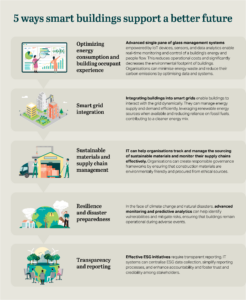Why buildings that live and learn will unlock a better future
In the race to achieve net zero, we can’t underestimate the role that smart building technologies will play in creating a sustainable and equitable future. Embedding technology through the lifecycle of a building, from the design process to day-to-day operations and even end-of-life solutions, is key to unlocking better and more sustainable outcomes for workplaces, homes, and communities, says Richard Morrison, Technical Director of Technology.
Optimising sustainability and user experience
The recent generation of buildings has already implemented smart technologies, such as Internet of Things (IoT) sensors to gather environmental and system inputs. Aspects of the workplace environment, like air quality, benefit from these inputs, relying on a fine balance of systems driven by sensors and user comfort feedback.
Today, as we design the next generation of buildings, artificial intelligence is advancing smart buildings even further by automatically adapting a building’s systems using IoT insights. Data analytics and artificial intelligence are valuable tools in making informed decisions about building design, maintenance, and resource allocation.
There are many ways to maximise Environmental, Social and Governance (ESG) outcomes in smart building design, such as measuring embodied carbon in the procurement process and using Environmental Product Declaration information to source low-carbon technology solutions.
It’s important to consider how people are likely to use the building in the future, analyse the efficiency across a portfolio, and consider aspects like popular transport modes and the demand for car parking spaces, all of which can significantly impact a building’s footprint and optimisation.
For organisations, tools and technologies can improve people’s living and working space. Augmented reality, artificial intelligence, laser scanning, artificial hygiene, and circadian lighting can all be used to support health and well-being. Considered and implemented thoughtfully, these tools play a vital role in unlocking a range of sustainable outcomes and improving business performance while engaging people to work together towards a low-carbon economy.
However, systems selection at the design and procurement stages is key to seamless integration. A powerful master systems integrator is a critical success factor of any next-generation smart building. This delivers a fast network for the building occupants, the capacity, speed, and flexibility to integrate all the building’s systems, and better ESG outcomes, particularly when followed-up with reporting, learning and optimisation, AI-powered insights and predictive maintenance.

The intersection of IT and ESG in buildings presents an incredible opportunity to drive sustainable and responsible practices. The components of ESG are interwoven with IT solutions that optimise energy consumption, enhance occupant well-being, track material sourcing, enable data-driven decision-making, promote resilience, and ensure transparency.
Organisations that embrace IT-driven ESG initiatives in their building infrastructure are not only fulfilling their social and environmental responsibilities but also positioning for long-term success in a world where sustainability is paramount. As technology continues to evolve, IT will remain an invaluable tool in creating a better, more sustainable, and equitable future for all.






